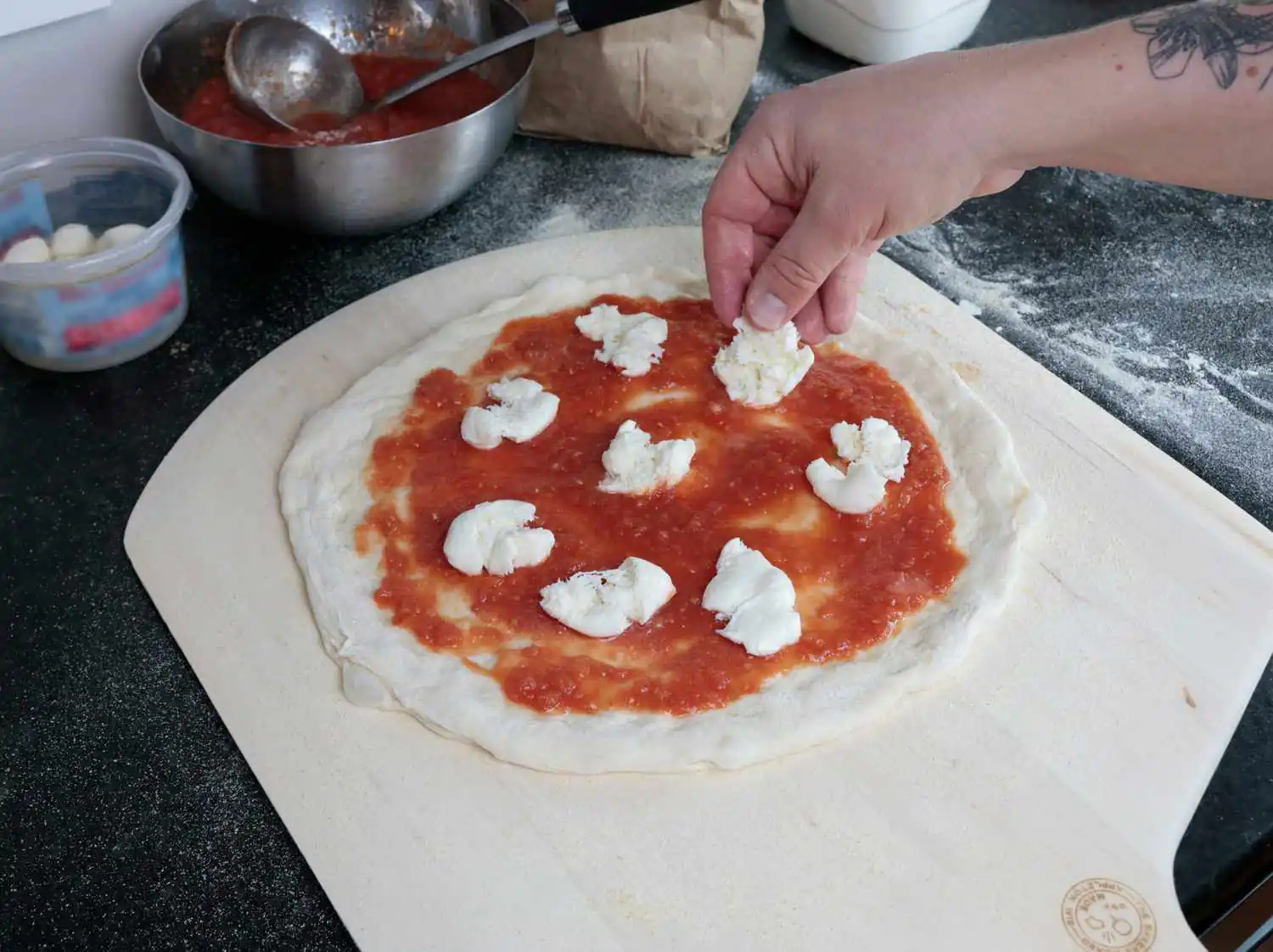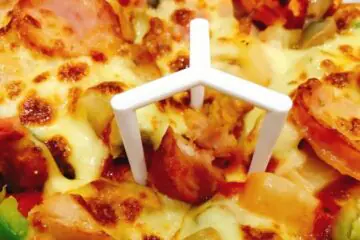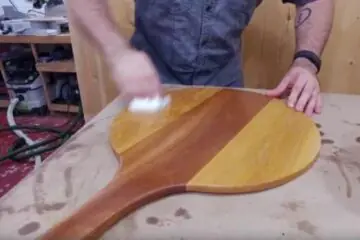In short, a wooden pizza peel is generally the best option for transferring the pizza into the oven, while a metal peel is better for turning and removing the pizza. Wooden peels are more durable and more accessible to slide underneath the pizza, while metal peels are preferred for their versatility and ability to handle high heat.
They also tend to be more affordable. Raw dough sticks less to wood peels than metal ones, making wood peels a popular choice among home pizza enthusiasts. Choosing wood and metal peel ultimately depends on personal preference and the user’s specific needs.
Wooden Pizza Peels: Traditional And Reliable
When choosing the best pizza peel for homemade pizzas, the debate between wood and metal peels is common. This article will discuss the advantages and drawbacks of using a wooden pizza peel, which has been the preferred choice of many pizza lovers for its traditional and reliable qualities.
Advantages Of Using A Wooden Pizza Peel
Natural texture reduces the risk of dough sticking
One of the main advantages of a wooden pizza peel is its natural texture, which helps reduce the risk of dough sticking to the peel. The wooden surface provides a slightly grainy texture that allows the dough to slide off easily onto the pizza stone, ensuring a smooth transfer and preventing mishaps during baking.
Easier transfer from peel to pizza stone
Wooden pizza peels are known for their ease of use when transferring the pizza from the peel to the pizza stone. The slight friction between the wooden surface and the dough helps maintain control and stability during the transfer, ensuring that your pizza slides off smoothly without any toppings getting stuck.
Traditional and preferred by many pizza aficionados
Wooden pizza peels have a long-standing history in traditional pizza-making techniques. Many pizza lovers prefer the wooden peel for its authenticity and the nostalgic feel when making pizza at home. The use of wood peels is deeply ingrained in the pizza culture and is considered by some as a symbol of authenticity and craftsmanship.
Drawbacks Of Wooden Pizza Peels
Potential for warping or cracking
One drawback of using a wooden pizza peel is the potential for warping or cracking over time. Wood is a natural material that can be affected by humidity and temperature changes, which may lead to the peel losing its original shape or developing cracks. Regular maintenance and careful storage can reduce the risk of warping or cracking.
Requires regular maintenance and seasoning
Wooden pizza peels require regular maintenance and seasoning to keep them in optimal condition. Herb helps prevent the dough from sticking onto the peel and also adds a protective layer to prolong the lifespan of the peel. Following the recommended maintenance practices for wooden peels ensures their longevity and performance.
While wooden pizza peels have drawbacks, they remain popular and reliable for many pizza enthusiasts. The natural texture, more effortless transfer, and traditional appeal make wooden peels preferred for those seeking an authentic pizza-making experience.
Metal Pizza Peels: Durability And Efficiency
When choosing the right pizza peel, it’s essential to consider factors such as durability and efficiency. Metal pizza peels, in particular, offer unique advantages that make them popular among pizza enthusiasts. In this section, we’ll explore the benefits and drawbacks of using a metal pizza peel so you can make an informed decision for your pizza-making endeavors.
Advantages Of Using A Metal Pizza Peel
More durable and sturdier than wooden peels: Metal pizza peels are known for their exceptional durability and sturdiness. Made from high-quality materials like aluminum, these peels are built to withstand regular use without quickly wearing out. This longevity ensures you can consistently rely on your metal peel to deliver excellent results.
More straightforward to slide underneath the pizza: Metal peels are designed with a smooth surface, allowing easy sliding. This makes it a breeze to transfer the pizza from the peel to the oven, minimizing any risk of mishaps or damage to the pizza.
Ideal for turning, moving, and removing pizzas: If you’re looking for a peel that offers versatility and flexibility in maneuvering pizzas, then a metal pizza peel is the way to go. Its thin and flat design allows easy turning, moving, and removing pizzas, giving you complete control over the cooking process.
Drawbacks Of Metal Pizza Peels
Increased risk of dough sticking: One drawback of using a metal pizza peel is the increased risk of dough sticking. Unlike wooden peels with a naturally textured surface that helps prevent dough from adhering to the peel, metal peels have a smoother surface that may cause the dough to stick. Prevent sticking: Dust dough with flour or cornmeal on the peel for an effective barrier.
Higher cost compared to wooden peels: Another drawback of metal pizza peels is their higher cost compared to wooden peels. Due to the materials used and their superior durability, metal peels tend to have a higher price tag. However, considering a metal peel’s long-term value and extended lifespan, the investment may be worth it for serious pizza enthusiasts.
Choosing The Right Pizza Peel For Your Needs
Choosing the right pizza peel can significantly impact your cooking experience when making delicious homemade pizza. Two popular options available are wood and metal pizza peels. Each has its unique advantages and considerations. This article will explore the factors to consider when deciding between wood and metal pizza peels and provide recommendations for different scenarios.
Factors To Consider When Deciding Between Wood And Metal:
Personal preference and cooking style
Your preference and cooking style are essential in selecting the right pizza peel. A wood pizza peel may be perfect if you appreciate the traditional charm of pizza making and enjoy a rustic touch. The natural texture and weight of the wooden peel contribute to an authentic cooking experience, allowing you to slide the pizza effortlessly onto the stone or grill. On the other hand, if you prefer a sleek and professional approach, a metal pizza peel might be more appealing. The smooth surface of a metal peel ensures easy maneuverability and efficient turning of pizzas during the cooking process.
Frequency of use and maintenance capabilities
Consider how frequently you plan to use your pizza peel and your maintenance preferences. Wood peels require more attention and care. They must be seasoned, periodically oiled, and kept away from excessive moisture to prevent warping. However, their natural moisture resistance and durability make them ideal for occasional home use. On the other hand, metal peels are relatively low-maintenance. They are easy to clean and do not require seasoning. Metal peels are an excellent choice for those who plan to use them frequently or professionally, as they can withstand high temperatures and heavy-duty usage.
Type of oven or grill being used
The type of oven or grill you use is essential when choosing between wood and metal pizza peels. Wood peels are well-suited for traditional or wood-fired pizza ovens, as their natural properties and heat retention abilities allow for proper pizza placement and transfer. On the other hand, metal peels excel in high-heat environments, such as brick ovens or outdoor grills. Their heat conduction and lightweight nature make them the go-to choice for professional settings and quick cooking scenarios.
Recommendations For Different Scenarios:
| Scenario | Recommended Pizza Peel |
|---|---|
| Traditionalists and enthusiasts | Wood pizza peel |
| Professional and frequent use | Metal pizza peel |
A wood peel is highly recommended for traditionalists and enthusiasts who value authenticity and a rustic cooking experience. Texture and weight ensure easy pizza transfer to stone or grill with optimal grip and control.
For those requiring a pizza peel for professional or frequent use, a metal pizza peel is preferred. Its smooth surface allows for efficient turning and moving of pizzas, ensuring a seamless cooking process. Metal pizza peels are also more durable and can withstand heavy-duty usage.
In conclusion, selecting the right pizza peel is crucial in achieving the perfect homemade pizza. Evaluating personal preferences, cooking style, maintenance capabilities, and the type of oven or grill used will help you decide between wood and metal pizza peels.

Credit: www.amazon.com
Conclusion
When it comes to choosing between a wood and metal pizza peel, it ultimately depends on your specific needs and preferences. A wooden peel is ideal for transferring the pizza into the oven, as it is sturdy and more accessible to slide underneath the pizza.
On the other hand, a metal peel is better for turning and removing the pizza. Both options have advantages, so having both types of peels for different purposes is recommended. Selecting the right pizza peel ensures a seamless cooking experience and a delicious result.

As the author of the “Ultimate Pizza Guide: Recipes, Tips & Secrets Revealed,” I’m dedicated to sharing my love for pizza and empowering others to create delicious homemade pizzas with ease. Join me on a journey to uncover the secrets to perfecting your pizza game!



